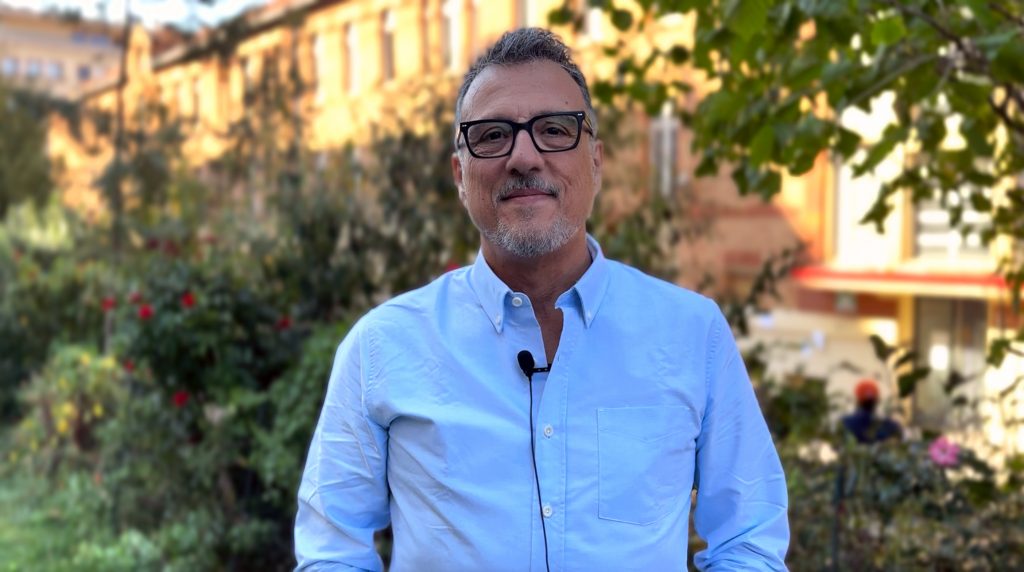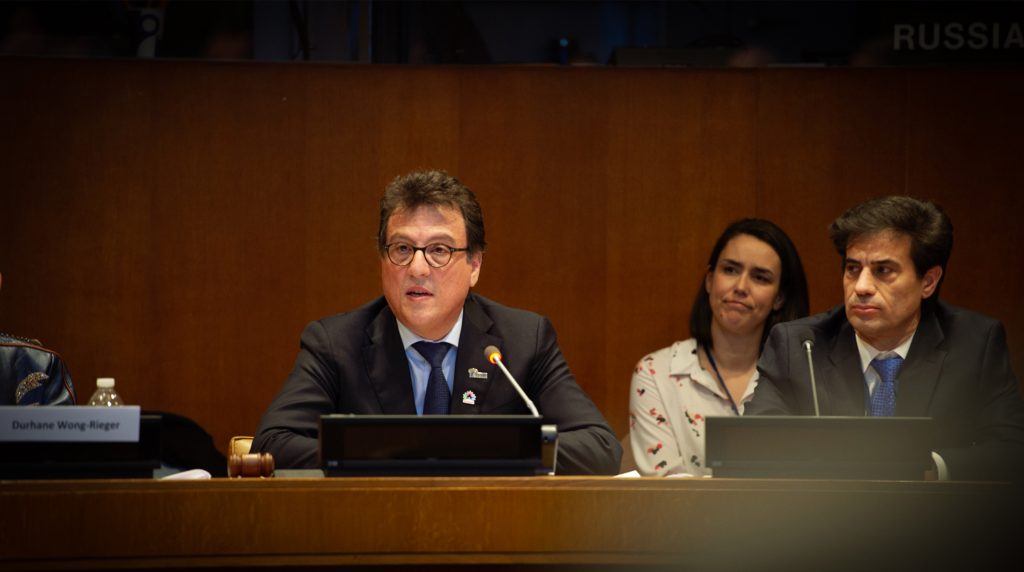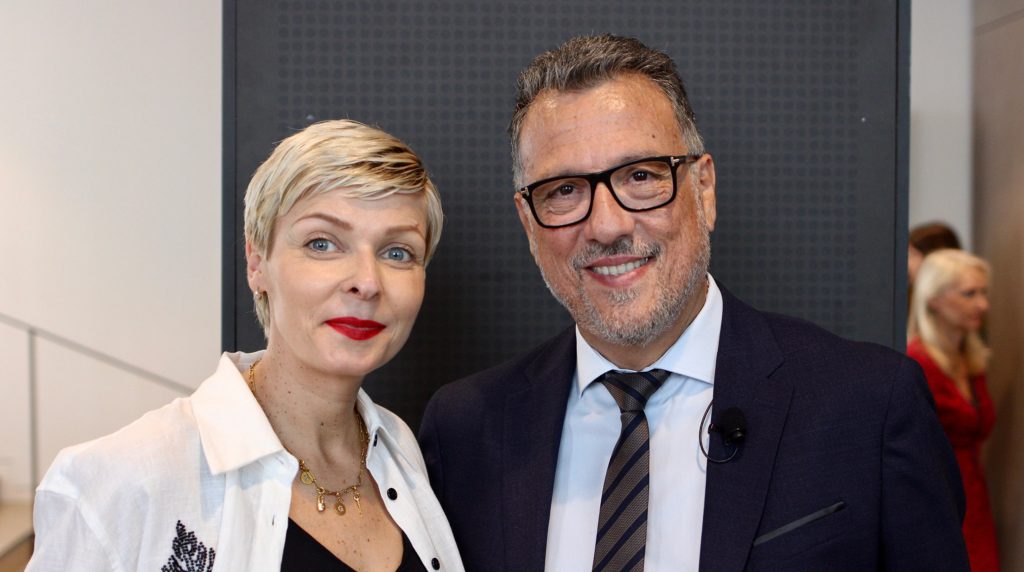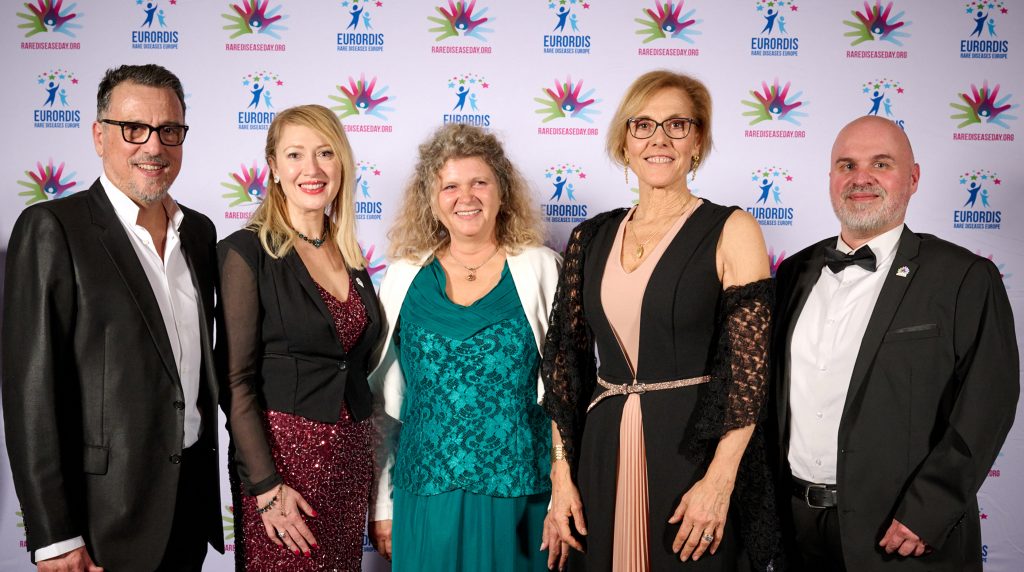Interview with Yann Le Cam: Reflecting on a Quarter Century as Chief Executive Officer
September 2023
On 13 September, Yann Le Cam, Chief Executive Officer of EURORDIS – Rare Diseases Europe, announced his decision to step down from his position at the end of March 2024, marking 25 years of leadership. As EURORDIS begins its search for a new CEO starting in April 2024, we spoke with Yann about the key strategies behind EURORDIS’ success over the past 25 years, its evolution, and its future.
Yann assumed the role of EURORDIS CEO in 2000, but the organisation’s origins can be traced back to 1993 when conversations initiated by Jean-Max Blum and Annie Wolf laid the foundation. Yann, in collaboration with partners such as AFM-Téléthon (Pierre Birambeau), Vaincre la Mucoviscidose (cystic fibrosis), the Ligue Nationale Contre Le Cancer, and AIDES, played a pivotal role in the early development of EURORDIS.
These discussions culminated in a significant conference at the French Senate in 1996, where rare disease patient organisations from across Europe, joined by Abbey Meyers, Founding Chief Executive Officer of the National Organization for Rare Disorders (NORD), and Marlene Haffner from the FDA Office of Orphan Drugs, came together to advocate for an EU Regulation on Orphan Medicines. This collective effort ultimately gave rise to what would later become EURORDIS – Rare Diseases Europe.
Since the legal incorporation of EURORDIS in 1997, what strategic choices have been key to the organisation’s successes?
When EURORDIS was established in 1997, our strategic approach was pivotal to our success.
We made the bold decision to unite all individuals living with rare diseases in Europe. This approach involved delving into the experiences of those affected by rare diseases, understanding their symptoms, clinical manifestations, and the social repercussions they faced. We took a holistic, public health-oriented perspective, covering over 6,000 rare diseases while considering the broader population. In other words: we took a public health approach.
This public health approach, centred on the unique challenges of rare diseases and their impact, set us apart. In the early ’90s, our ethos differed from that of the US National Organization for Rare Disorders (NORD), which primarily focused on creating legislative and research conditions favourable to orphan drug development. Our vision for Europe wasn’t limited to medicine or therapy development, genetic origins, or disease aetiology. Instead, we aimed to address the comprehensive needs of individuals and the broader population.
“First and foremost, our success lied in recognising the commonalities among people living with rare diseases and their families.”
First and foremost, our success lied in recognising the commonalities among people living with rare diseases and their families. EURORDIS united all rare diseases across European countries, forming a critical mass of 25 to 30 million people that could no longer be ignored. This strategic approach transformed us from shadows to the limelight, from indifference to recognition, from ignorance to knowledge, and from isolated despair to shared hope.
The second crucial decision was not merely building an organisation but fostering a movement. We envisioned EURORDIS as an enduring, open, and adaptable movement, not just a confederation of national alliances like many other European organisations. In the early ’90s, Rare Diseases Denmark was the sole national alliance in Europe. From the outset, our membership welcomed European and international federations, national alliances as they emerged, and patient groups of varying sizes and diseases. We ensured a home for every rare disease within our broader movement.
Today, this movement is firmly established. National alliances have sprung up in numerous European countries, forming a tightly interconnected network, although their maturity and activities vary. Over the years, more than 70 European and international federations representing individual or groups of rare diseases have emerged, amplifying the voice of those affected and their families. They also form a European network within EURORDIS, increasingly aligning with the National Alliances. In the years ahead, we must redouble our efforts to support national alliances, European federations, and enhance our overall impact.
Thirdly, we recognised the power of uniting a community of rare disease organisations to enhance our collective capacity to drive change. We understood the need for a strategic approach, akin to business strategy methods applied to the nonprofit sector. My own decade-long experience in the field of AIDS and HIV before EURORDIS had shown me the challenges faced by European and international organisations in functioning effectively. Similar capacity issues existed in the field of cancer during my experience in the ‘80s and ‘90s. I’ve always believed that for a civil society organisation, strong governance is paramount. Achieving excellence in governance, shared values, and strategic objectives is essential. Board alignment and the collaboration between the President and the CEO are necessary ingredients for success, albeit not sufficient on their own.
Fourth, I’ve held the conviction that the inherent challenges posed by rare diseases, stemming from their rarity, necessitate collaboration at both the European and international levels. Moreover, it’s imperative to partner with all stakeholders, forming a community of diverse private and public stakeholders. This coalition draws on each other’s strengths and combines resources. Over the years, EURORDIS leaders have become adept diplomats, bringing together patient advocates, scientists, clinicians, healthcare managers, healthcare system payers, companies, regulators, and policymakers. They’ve surfaced the respective interests of these stakeholders and designed mutually acceptable paths forward, all in service of individuals affected by rare diseases and their families. EURORDIS stands as a European civil society organisation forging a European public interest and creating common goods.

What was the organisation like during the first couple of years upon it being founded in 1997?
It was a bumpy road.
AFM-Téléthon played a pivotal role by providing invaluable support, both in terms of expertise and financial backing. They engaged some of their seasoned staff, like Marc Bouillet, and dedicated volunteers, such as Françoise Salama, to guide our development and assist with legal and policy matters. AFM-Téléthon’s financial support ensured that we could establish EURORDIS as an independent, patient-driven organisation and kickstart our advocacy efforts for orphan drug regulation and the first European Commission policy on rare diseases.
At that time, I was serving as the Director General of AIDES, France’s major HIV/AIDS national organisation. In fact, our first two staff members at EURORDIS came from AIDES, including Stephan Korsia, who led our efforts in therapeutic education and advocacy.
Our initial aim at EURORDIS was to secure the European Regulation on Orphan Medicinal Products. Why this focus? Because we recognised an opportunity within the emerging EU Single Market to attract investment in a research field where there was little market potential in the EU. Subsequently, we shifted our attention to the broader EU Pharma Regulation of 2003, the EU Regulation on paediatric use of medicines in 2006, and the Regulation on Advanced Therapies, such as Gene and Cell Therapies, in 2007. It was through this legislative momentum, linked to the internal market, that we successfully advocated for the inclusion of rare diseases in the EU Research Programme and the EU Public Health Programme.
Our Board consisted of highly skilled, experienced, and passionate individuals, many of whom have continued to champion rare diseases in the years that followed. However, it took time for us to bridge our differences in needs and perspectives across various disease areas and diverse European cultures. We realised that becoming a truly pan-European organisation, speaking with one unified voice, would be a gradual process.
In 1998, a year after EURORDIS was founded, I joined AFM-Téléthon as an Advisor to the President and Director General. In just two years, I spearheaded advocacy efforts that led to the adoption of the EU orphan regulation in 1999. During that time, I also organised the first Walk for Rare Diseases in the south of France, televised for maximum impact. In 1999, I initiated the first Citizen Consensus Conference on Rare Diseases and led the development of the inaugural public health report on rare diseases, co-authored by academic leaders like Ségolène Aymé in 2000. I played a pivotal role in uniting patient advocates and co-founded the French national rare disease alliance (Alliance Maladies Rares) in March 2000, along with 39 associations. Within the scope of my activities, I was again responsible for the development of EURORDIS with Anders Olauson serving as President of the organisation.
“During that first year, I served as CEO on a voluntary basis, without a salary, simply because we lacked the financial means. This was the point where my family probably questioned my sanity.”
I left AFM Téléthon, and a few months later, I joined EURORDIS as CEO. During that first year, I served as CEO on a voluntary basis, without a salary, simply because we lacked the financial means. This was the point where my family probably questioned my sanity. They couldn’t quite fathom why I had studied at the best business school and majored in strategy if I was going to make choices like these in life!
However, only a year later, AFM Téléthon embraced the strategy and plan we crafted with our new Board, led by Lesley Greene. In 2000, we initiated a comprehensive overhaul of EURORDIS, essentially starting anew. Our first step was to revitalise our membership, culminating in a pivotal gathering in Barcelona in 2001. Our primary objectives were to establish common strategies for addressing shared needs and challenges, define our shared values, inspire our members, clarify our purpose, and chart a collective path forward.
In those early days, Terkel Andersen, our new Board president, and I worked tirelessly to spread the word, spark enthusiasm, harness untapped energies, and shape the vision for something that was still in its infancy – a formidable undertaking. This challenge continues to be part of our journey today, and I’ve never underestimated its significance. I staunchly believe that imagination is a form of knowledge, and I’m dedicated to translating words into action.

In comparison to today, what was the daily job like when you first assumed the role of Chief Executive Officer at EURORDIS?
It’s completely different. Well, most of it is different.
Back in 2000, I wore many hats – I mean, all the hats, from A to Z. My only support was a part-time intern serving as an administrative assistant. Essentially, I was the entire team, the Chief of just myself! I found myself in a situation similar to that of many rare disease patient organisations even today – limited resources, working round the clock, often from the kitchen table. I was constantly on the move, reaching out to advocates in different countries, and doing whatever it took to keep things moving forward.
In that same year, the European Commission appointed three patient representatives to the newly established Committee on Orphan Medicinal Products (COMP) at the European Medicines Agency. After a series of votes, I was elected as the Vice Chair of COMP, with Professor Josep Torrent as the Chair. This was a remarkable and unexpected opportunity. Serving in this position was instrumental in bringing the needs of people living with rare diseases to the forefront in regulatory and political contexts. Three years later, I was re-elected as the Vice Chair of COMP in a single round of voting – a sign that patient advocates had truly made their mark at the EMA.
Soon, I was fortunate to have some additional support. A former colleague from my time working in international cancer research, Christina Black, joined me as my assistant. She was a multi-lingual Swiss-knife of sorts. Additionally, a young mother with a scientific background, Hawa Dramé, who had tragically lost her two children to mitochondrial diseases, came on board to assist the three patient advocates in the COMP at the EMA. Together, we began to lay the foundation for EURORDIS’ continued growth and impact.
Reflecting on the past 25 years, what achievements and areas of EURORDIS’ growth have most impressed you?
It is important to clarify that growth was never an explicit objective for EURORDIS, nor should it ever be. Rather, growth should be viewed as a means to an end – a result of deliberate choices made to address identified challenges.
Certainly, for EURORDIS to be a legitimate advocate, it needed a robust membership base defined by clear criteria and shared interests. If I were to pinpoint an area of growth that has truly impressed me, it would be the expansion of our membership. Twenty-five years ago, none of us could have foreseen that EURORDIS would one day boast more than 1,000 members, indirectly encompassing over 2,000 patient organisations through our national alliances in various countries. In fact, back in the early 2000s, there weren’t as many patient organisations as we see today. The growth of patient organisations is a testament to scientific progress and the vitality of civil society, driven by families affected by rare diseases.
Another remarkable facet of EURORDIS’ growth is our network of volunteers. When I embarked on the journey of recruiting a community of volunteer patient advocates at the European level, I encountered significant scepticism and discouragement. Many doubted the feasibility of such an endeavour. Consequently, I take immense pride in the fact that we’ve successfully nurtured a robust community of volunteers.
“When I embarked on the journey of recruiting a community of volunteer patient advocates at the European level, I encountered significant scepticism and discouragement.”
These volunteers bring a wealth of knowledge and experience to EURORDIS, each hailing from different backgrounds, affected by different diseases, and navigating their unique rare disease journeys. They transcend their personal stories, diseases, and national borders, generously contributing their time and expertise in a highly professional manner when collaborating with the EURORDIS team. In a landscape where clinicians lead the European Reference Networks (ERNs), these volunteers are the unsung heroes, working tirelessly to advance the rare disease cause.
Why have you chosen to leave EURORDIS in April 2024?
First and foremost, it has been clear to both the Board and me that a leadership transition, including the role of CEO, is an essential element for the long-term sustainability and performance of EURORDIS. This transition has been a six-year endeavour, carefully prepared by Terkel Andersen, who served as President for 18 years, and myself. It’s worth noting that the transition extends beyond the CEO position; it begins with the leadership of the Board itself. In 2022, Terkel stepped back from his role one year earlier than planned due to health reasons, and Avril Daly became our new President. We also welcomed two new Vice-Presidents, Dorica Dan and Simona Bellagambi, a Secretary General, Geske Wehr, and a Deputy Secretary, Anna Arrellenesova, along with a Treasurer, Alain Cornet. Together, they form a robust and well-aligned leadership team, with a mix of long-standing members contributing institutional knowledge and new members ready to usher in a new chapter.
Additionally, after a comprehensive review of EURORDIS’ strategy up to 2030, based on the Rare 2030 foresight study and extensive consultation with our members, staff, and lead volunteers, I am confident that this new Board is well-equipped to guide the organisation toward achieving its established objectives. The strategic roadmap is in place for my successor, and the Board is fully committed to supporting the incoming Chief Executive.
Secondly, I believe that EURORDIS has now reached a level of organisational maturity. We have developed a structure that includes colleagues with the expertise, know-how, and management capabilities to lead in various areas of our mission, working collaboratively and leveraging our extensive networks.
Thirdly, in contrast to the past decade, when my role effectively encompassed several positions, we have made decisions to streamline the CEO role, making it more straightforward for a new leader to step in.
Lastly, 2025 will mark the beginning of discussions regarding the EU’s next multiannual financial framework (MFF), the next EU Public Health Programme, and the next EU Research Framework Programme, all slated for 2028–2034. With elections to the European Parliament scheduled for the next year, it is crucial that the incoming CEO assumes the position in 2024, allowing them to navigate the intricate landscape of the rare disease ecosystem and engage in the early stages of these vital policy developments, shaping the future of rare disease policy for the next five years.

What is EURORDIS looking for in its next Chief Executive Officer? And what would your advice be to your successor?
In our search for the next Chief Executive Officer, EURORDIS is primarily seeking a person who gets it, someone who deeply understands what it means to live with a rare disease, and is fully aware of the challenges faced by rare disease patients, their families, and society at large. This understanding is paramount, as it forms the foundation of our work and advocacy.
“My advice to my successor would be to keep a strong focus on people, because at the heart of everything we do are the individuals and families affected by rare diseases.”
We’re looking for someone who can be a ‘we’ person; someone who can speak on behalf of the community with full legitimacy and credibility.
Above all, we value a candidate who places the organisation’s mission above their personal interests and who recognises that the needs of people living with rare diseases take precedence over the organisation itself. The role of CEO is fundamentally about serving the people, the cause, and the broader movement.
My advice to my successor would be to keep a strong focus on people, because at the heart of everything we do are the individuals and families affected by rare diseases. Without this compass, navigating the complex landscape of rare diseases becomes challenging.
It is essential to maintain a clear long-term vision across various areas, including research, healthcare, and social inclusion, while identifying opportunities at the local, national, European, and international levels. Simultaneously, one should be vigilant about achieving short-term and medium-term victories. Progress in the field of rare diseases is often incremental, and these incremental steps build the foundation for more significant advancements.
Finally, my advice would be to always remember to trust people and believe in the strength of collective actions within an agile and open movement.
The EURORDIS Board of Directors have launched the search for our next Chief Executive Officer and are seeking a leader who shares the organisation’s vision and commitment to improving the lives of the 30 million people with rare diseases across Europe. Apply before 18 October.
Julien Poulain, Communications Manager
